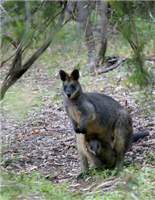Family
MacropodidaeGenus
Wallabia
Species
bicolor
Threats/Control Methods - Regional
A decrease in the population of Swamp Wallabies has occured since European settlement due to habitat destruction and fragmentation. To a much lesser extent, they are threatened by predation.
Threats/Control Methods - Local
Free-roaming domestic dogs may attack this species in urban nature reserves. The Swamp Wallaby is at risk of being hit by cars on roads bordering nature reserve areas.Local/Urban Actions
Swamp Wallabies are wild animals and should be treated as such. These are recommendations from Environment ACT relating to human contact with kangaroos." Keep a safe distance of 30-50 meters. If you distress the animal, it could become aggressive. " Take note of where the animal was last seen and let your neighbours know, especially if they are dog owners. " Please make sure that dogs are on their leashes at all times, as is required by law. " Do not feed the Swamp Wallabies. Feeding wild animals creates a dependency relationship on humans, creating an artificial environment with ultimately negative consequences for the animals. Participating in tree planting or bush regeneration activities with local Landcare groups or with Greening Australia will improve habitat areas for this species.
Common name/s
Swamp Wallaby, Black Wallaby, Black-tailed Wallaby, Fern Wallaby, Black Pademelon, Black Stinker.
Distinguishing Features
The Swamp Wallaby is a medium sized member of the kangaroo (macropodid) family, with an 80cm head and body length and a 70-80cm tail. Their coarse fur is dark brown coloured on the upper body with lighter rusty patches on the under body, chest and base of the ears. Many Swamp Wallabies also have a lighter brown cheek strip.
Similar Species
The Brush-tailed Rock-wallaby (Petrogale penicillata) is smaller, with a thicker tail and a preference for much rockier habitat areas.
Distribution
The species occurs in eastern Australia from Cape York in QLD to southwestern VIC.
Country of Origin
Australia
Survey Techniques
This species was identified during night searches and using scats.
Conservation (Pet/Pest) Status - National
Secure, not listed under the EPBC Act 1999. This species is protected native animal and can only be taken with a licence issued by National Parks and Wildlife Services.
Conservation (Pet/Pest) Status - Regional
Common
LSCCES Population
Common
Associated vegetation community
Swamp Wallabies inhabit areas with understorey and are generally found in dense forests, woodlands, heath and swamplands.
Limiting Resources
This species depends on thick ground cover, a thick shrub layer and a sheltering forest environment. Moisture is also important, as it is usually found sheltering in damp spots on hillsides.
Breeding
Breeding occurs continuously throughout the year, and like many species in the Macropod family, Swamp Wallabies can suckle two joeys of different ages. After a gestation period of 33-38 days, each joey spends eight to nine months in its mother's pouch, continuing to suckle until up to 15 months of age. Swamp Wallabies, both male and female, attain sexual maturity at an age of 15 months and may live up to 15 years in the wild.
Behaviour
Swamp Wallabies are usually a solitary species though occasionally loose feeding groups form. It spends the daytime sheltering in thickly vegetated forest areas, before emerging in the late evening to feed on nearby grasses and shrub plants.
Functional Group
Food Species
Swamp Wallabies are graziers and eat grasses, shrubs like bracken fern and soft plants. Occasionally they have been known to eat bark and shoots from pine trees. They will also graze some agricultural crops with close range to suitable shelter.
Predators
Dingoes (Canis lupus), Dogs (Canis familiaris) snakes and birds of prey will attack this species and kill the young.
Interesting Fact
The Swamp Wallaby has unique genetic, reproductive, dental and behavioural characteristics that make it different to other wallabies and eligible to be classified as the last living member of the genus Wallabia.
References - (reader suitability of references, P=Primary teachers, S=Secondary students, T=Tertiary students and researchers)
Books:Straham, R. 1983. The Australian Museum Complete Book of Australian Mammals. The National Photographic Index of Australian Wildlife. Angus and Robertson Publishers. Sydney. P, S, T
Journals:Troy, S. and Coulson, G. 1993. Home Range of the Swamp Wallaby, Wallabia bicolor. Wildlife Research. Vol. 20: 571-7 T
Online Publications:Ellis, J. 2000. Wallabia bicolor. Animal Diversity Web. [online]. Available at: http://animaldiversity.ummz.umich.edu/site/accounts/information/Wallabia_bicolor.html. P, S, T
Environment ACT. 2006. Kangaroos in our Nature Parks and Reserves. [online]. Available at: http://www.environment.act.gov.au/petsandlocalwildlife/localwildlife/kangaroosinnaturereserves P, S, T
Tidemann, C., Roscoe, T. and Mitchell, B. 2006. Mammals of the Lower Sullivans Creek Catchment, Canberra ACT. Prepared for the Life in the Suburbs project using data from the Lower Sullivans Creek Catchment Ecological Survey (LSCCES). Australian National University. Canberra. [online]. Available at: http://www.lifeinthesuburbs.com.au/category.php?id=65 S, T
Researchers: Hedda Ranson-Elliott and Naomi Hogan

 Top
Top Top
Top